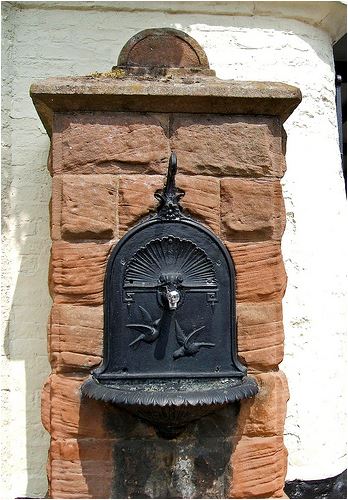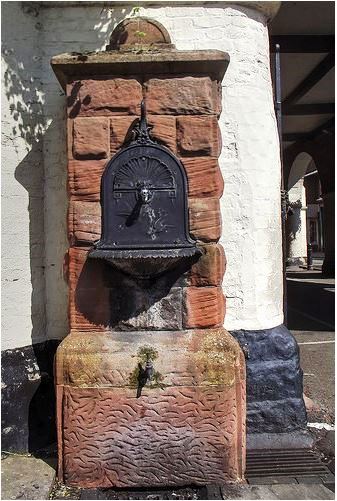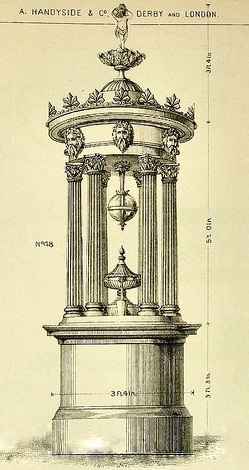Location: Cleethorpes, Lincolnshire, England
When the bucket fountain was removed from St. James Square in the 1970s, a canopied drinking fountain was installed in its place (unfortunately, I cannot find any information on the original location of this drinking fountain which was officially unveiled in 1869 by Mayor Edward John Bannister.) It was restored in 1977 and recorded as a Grade II historic building on 30 June 1999, and then delisted in November of the same year. It was removed and put into storage by North East Lincolnshire Council.
Drinking fountain number 8 from Walter Macfarlane & Co.’s catalogue was manufactured at the Saracen Foundry at Possilpark in Glasgow. The structure was 9 feet 6 inches high and consisted of four columns. Griffin terminals spouting water united with arches formed of decorated mouldings.
Four rope moulded cartouches hosted the Great Grimsby Coat of Arms comprised of a chevron between three boars’ heads, and two inscriptions Presented By The Mayor 1869, and Restored Jubilee Year 1977. The arches above two lunettes were inscribed with the useful monition, Keep The Pavement Dry. Civic virtues such as temperance were often extolled in inscriptions on drinking fountains. The structure was surmounted by an open filigree dome, the finial being a crown with a pattée cross.

Under the canopy this design usually contained a font with a crane terminal. However, the crane is not present in photographic evidence which probably means that it was either stolen or removed. The basin (2 feet 6 inches in diameter) which had a scalloped edge and decorative relief was supported by a single decorative pedestal with four pilasters and four descending salamanders, a symbol of courage and bravery. A central urn with four consoles offered drinking cups suspended by chains. The fountain was operated by pressing a button. Water also spouted from the mouths of the griffin capitals.
Symbolism was popular in Victorian times. Griffins are symbolic of guardians of priceless possessions, salamanders display bravery and courage that cannot be extinguished by fire, and cranes are recognized as a symbol of vigilance.

St. James hotel in background

Circa 1977

Circa 1980

A1244574540
*UPDATE September 2019. A reader of my blog, Robert Alcock, has notified me that he believes he has found the canopy of the “Cleethorpes” drinking fountain removed from St James Square Grimsby in the late 70’s. It is in a salvage Yard near Louth Lincolnshire.
Glossary
- Capital: The top of a column that supports the load bearing down on it
- Cartouche, a structure or figure, often in the shape of an oval shield or oblong scroll, used as an architectural or graphic ornament or to bear a design or inscription
- Console: a decorative bracket support element
- Filigree, fine ornamental work
- Finial, a sculptured ornament fixed to the top of a peak, arch, gable or similar structure
- Griffin, winged lion denotes vigilance and strength, guards treasure and priceless possessions
- Lunette, the half-moon shaped space framed by an arch, often containing a window or painting
- Pattée cross, a cross with arms that narrow at the centre and flare out at the perimeter
- Pedestal, an architectural support for a column or statue
- Pilaster, a column form that is only ornamental and not supporting a structure
- Terminal, statue or ornament that stands on a pedestal














